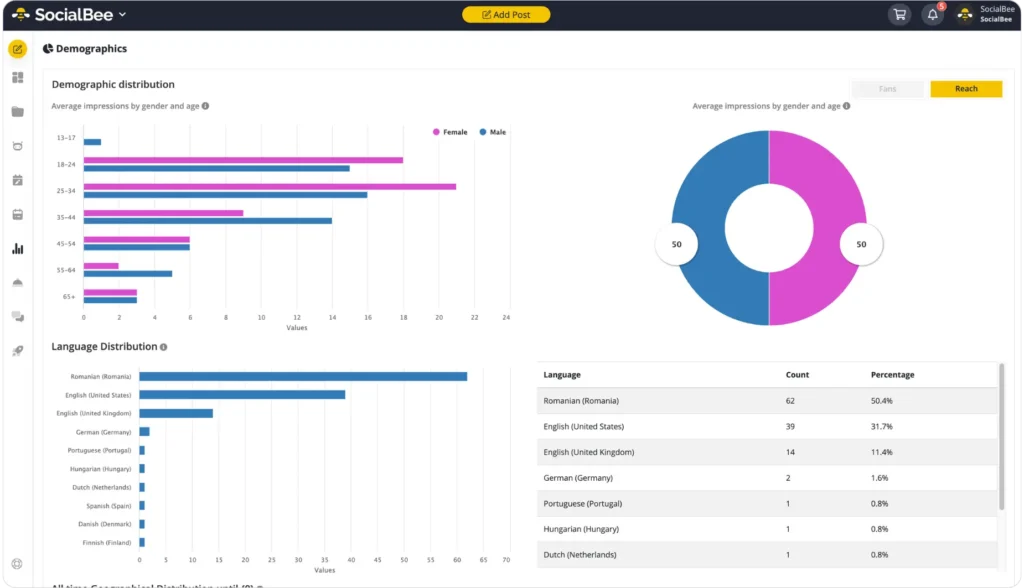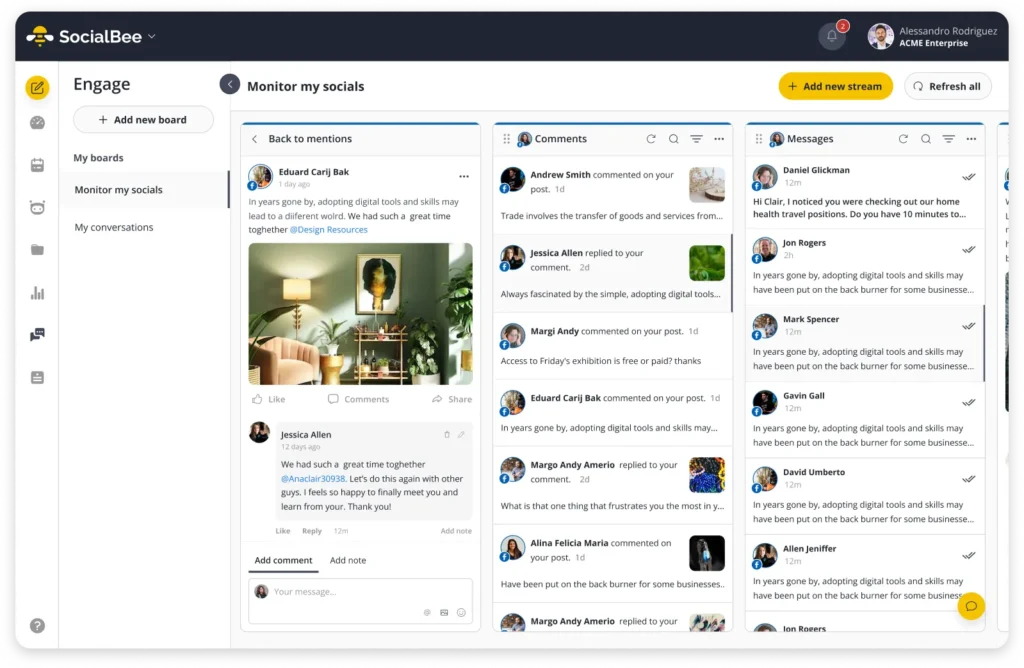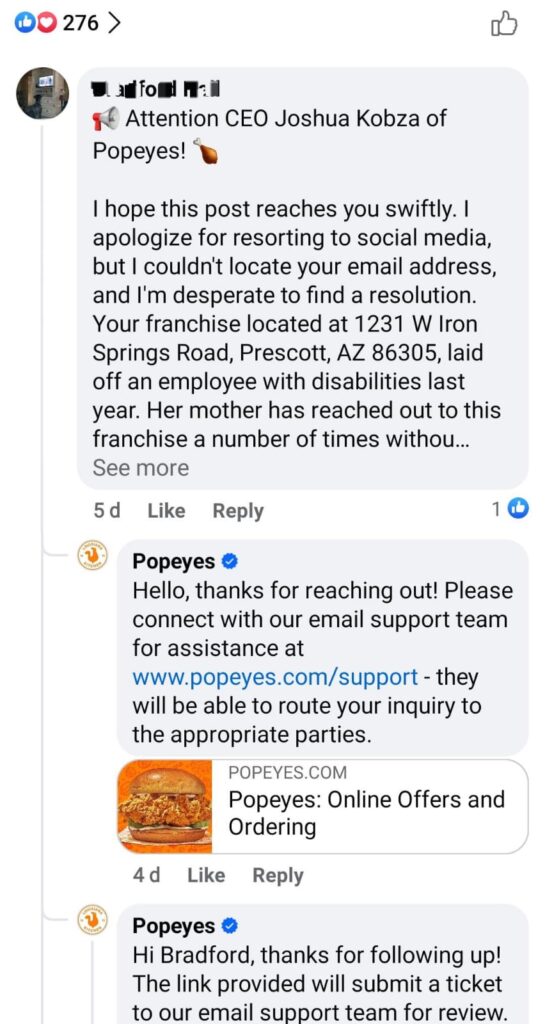
Content Writer at SocialBee
How can social media community management evolve from reach to engagement? This question sets the tone for modern digital marketing strategies, where creating a vibrant online community is the secret to brand success.
In an age where every scroll, like, and comment represents an opportunity to connect with audiences, mastering social media community management has never been more critical. Throughout this article, we will delve into the strategies that empower brands to navigate the ever-evolving landscape of social media.
From answering difficult questions to engaging your audience, each strategy we explore can amplify the impact of your community management efforts. Shall we begin?
We’re SocialBee LABS SRL, part of WebPros. We use the information you provide to share relevant content and product updates, as outlined in our Privacy Policy. You can opt out anytime.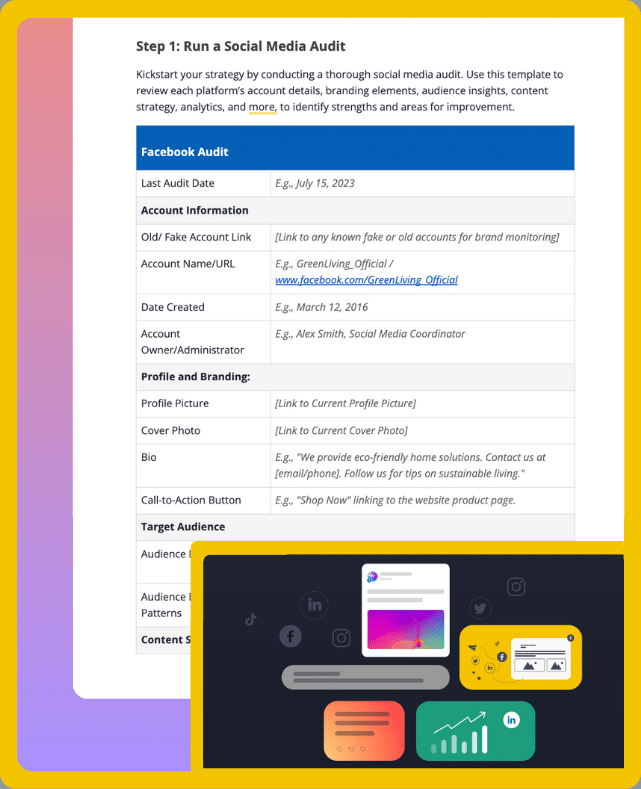
Short Summary
- Social media community management refers to cultivating and engaging with online communities centered around brands across social media platforms.
- A community manager’s job includes audience engagement, content creation, relationship building, reputation management, and community growth.
- A successful community management strategy fosters meaningful relationships, drives brand advocacy, enhances customer experience, generates valuable insights, and manages crises effectively.
- Use analytics data like your audience’s demographics, interests, and behaviors to develop detailed customer personas.
- When you combine analytics with surveys and market research, you can identify where your audience spends time online and their content preferences.
- Align your KPIs with broader business objectives. Focus on quality metrics over vanity ones, prioritizing comments, shares, mentions, and conversions.
- Track mentions of your brand across various platforms and identify both direct and indirect mentions.
- Pay attention to brand sentiment analysis to gauge the overall perception of your business. While positive sentiment is desirable, negative feedback can also provide opportunities for improvement.
- Experiment with different types of posts, such as polls, questions, quizzes, and contests, to boost interaction and participation.
- Leveraging tools like SocialBee streamlines your community management efforts, offering platform support, AI content creation, strategy generation, visual content calendars, content creation integrations, and comprehensive analytics.
- Creating a content creation feedback loop involves actively seeking and analyzing feedback, empowering community participation, and transparently incorporating feedback into content strategies.
- Setting clear community rules and guidelines fosters a positive and respectful online environment, prioritizing respect, positive engagement, and transparent moderation.
- Constantly checking on the community’s needs, showing appreciation to community members, maintaining brand voice consistency, and preparing to answer difficult questions are essential for effective community management.
What Is Social Media Community Management?
Social media community management involves moderating online interactions, engaging with followers, and creating content to build a positive environment around a brand or organization. It includes responding to comments, mentions, and messages, and analyzing engagement data.
What Is a Social Media Community Manager?
A social media community manager is the person tasked with developing and nurturing a lively online community around a brand, product, or organization across various social media channels.
Key responsibilities of a social media community manager include:
- Engagement: Interacting with followers through comments, messages, and user-generated content to foster a strong sense of connection and community.
- Content creation and curation: Developing and curating content that resonates with the community’s interests and preferences.
- Relationship building: Cultivating relationships with influencers, brand advocates, and other stakeholders to amplify the brand’s reach and credibility.
- Reputation management: Monitoring conversations surrounding the brand and addressing any issues or concerns promptly to maintain a positive brand reputation.
- Community growth: Strategically implementing initiatives to grow and expand the community.
Why Do You Need a Social Media Community Management Strategy?
By developing and executing a comprehensive community management plan, brands can position themselves for long-term success and sustainable growth.
Here’s why you need a social media community management strategy:
- Fostering meaningful relationships: Engaging with followers, replying to comments and DMs, and actively participating in conversations allows brands to establish a real connection with community members.
- Driving brand advocacy: A social strategy that focuses on strong connections and positive interactions can help amplify brand advocacy and word-of-mouth marketing, leading to increased brand visibility and credibility.
- Enhancing customer experience: A well-executed strategy allows brands to address customer inquiries, needs, and feedback effectively.
- Generating valuable insights: Strategic community management provides brands with valuable insights into consumer behavior, market trends, and the competitive landscape. These insights can be leveraged for strategic decision-making, product development, and marketing initiatives.
- Crisis management and reputation building: Proactively addressing issues, providing transparent communication, and demonstrating genuine concern for the community’s concerns enables brands to maintain credibility among their audience.
The 7 Elements of Community Management
Effective community management on social media requires a multifaceted approach that encompasses various elements. From content creation to crisis management, each aspect plays a vital role in fostering a vibrant and engaged online community.
Here are the seven elements of community management:
- Content creation and curation: Community management relies on developing and sharing diverse, relevant content formats that align with the interests and preferences of its audience.
- Engagement and interaction: Brands must actively engage with followers, responding to comments, DMs, and mentions. This encourages consistent participation and strengthens bonds within the community.
- Moderation: Monitoring discussions, enforcing community guidelines, and addressing inappropriate behavior ensure a safe space for all community members to thrive.
- Feedback collection and analysis: Social media managers solicit feedback through surveys, polls, and open-ended questions, leveraging data to uncover trends and opportunities. Analyzing feedback empowers informed decision-making and drives continuous improvement.
- Advocacy and relationship building: Recognizing and rewarding community contributions solidifies bonds and helps to identify brand ambassadors.
- Crisis management: Open communication, acknowledgment of concerns, and timely updates reassure the community and mitigate reputational damage.
- Analytics and reporting: Analyzing performance data reveals successes and areas for improvement, guiding future strategies for maximum impact.
10+ Best Tactics for Social Media Community Management
To ace social media community management, you must employ a strategic approach.
Here are the best tactics for social media community management:
- Determine who your audience members are
- Define KPIs to track your progress
- Monitor conversations about your business
- Constantly engage your community members
- Leverage the right community management tools
- Create a content creation feedback loop
- Set community rules and guidelines
- Check on your community regularly
- Show appreciation to your online community
- Maintain your brand voice across all social media accounts
- Prepare to answer difficult questions
1. Determine Who Your Audience Members Are
Explore analytics from your social media management platform to gain a broad understanding of your audience’s demographics, interests, and behaviors. Use this data to develop detailed audience personas.
Create fictional identities that represent each segment, including their goals, pain points, motivations, and preferred communication methods.
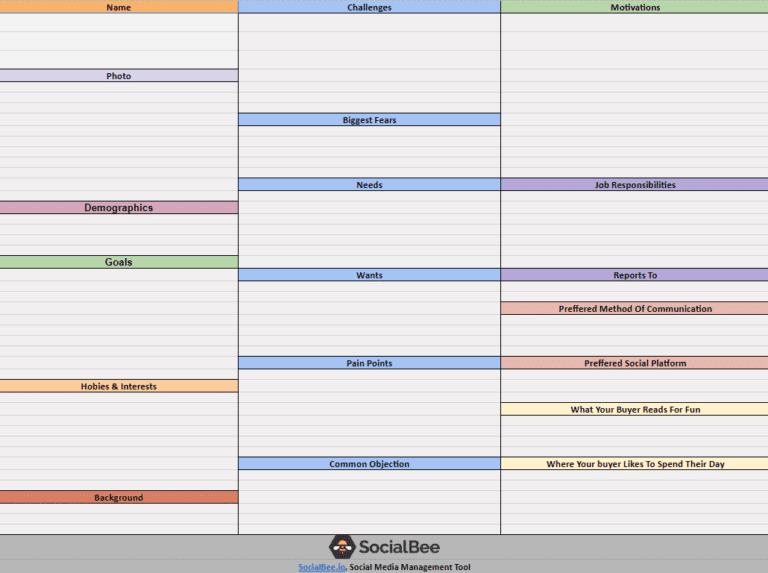
Understanding your audience through these personas is essential for effective social media community management. When you combine analytics with surveys and market research, you can easily identify where your audience spends time online and their content preferences.
The easiest way to about your audience’s behavior, demographics, and engagement with your posts is through SocialBee‘s centralized, real-time insights that provide all the data you need.
Learn all about your online community with SocialBee’s analytics.
This approach empowers you to make strategic decisions on how to engage effectively with your community.
2. Define KPIs to Track Your Progress
Defining key performance indicators is paramount for effectively tracking progress and evaluating the impact of your strategies. To begin, align your KPIs with broader business objectives, ensuring they reflect goals such as brand awareness, engagement, lead generation, sales, or customer retention.
Focus on quality metrics over vanity ones, prioritizing indicators like comments, shares, mentions, and conversions to gain deeper insights into audience interaction.
Here are a few examples of KPIs that you can align with broader business objectives:
Business Objectives | KPIs |
Increase Community Engagement |
|
Enhance Brand Awareness |
|
Gather Valuable Customer Insights |
|
Resolve Customer Issues and Queries |
|
Foster Community Advocacy |
|
Depending on the specific goals of your organization or community, you may need to tailor these objectives and metrics to align with your unique needs and priorities.
3. Monitor Conversations About Your Business
To effectively monitor these conversations, start by utilizing social media listening tools to track mentions of your brand across various platforms.
This can help you identify mentions in real time, keeping you alert about what people are saying regarding your brand online. Moreover, it allows you to reply promptly, provide quick support, de-escalate any unpleasant social media interaction, and prevent crises.
Here’s how a social listening tool can enhance your community monitoring efforts:
- Unified messaging: Access to messages, comments, and mentions from diverse social media accounts in a single dashboard simplifies monitoring and management tasks.
- Message filtering: Having messages organized based on specific criteria such as platform, date, or message status facilitates the prioritization of responses.
- Team collaboration: Streamlining teamwork by allowing team members to assign conversations, mark messages as handled, and leave internal notes allows for effective collaboration.
- Notifications: Receiving instant updates whenever your brand is mentioned enables you to respond promptly to any comments, questions, or concerns your audience raises.
SocialBee’s Engage Module helps you keep track of brand mentions, stay on top of community feedback, and address inquiries and issues effectively.
Engage with your audience from SocialBee’s centralized dashboard.
With SocialBee, you can reply to all your messages, mentions, and comments from a unified dashboard to save time and energy when managing online interactions.
PRO TIP: Don’t limit your monitoring efforts to just your own social media channels. Expand your scope to include relevant hashtags, industry keywords, and competitor mentions to gain a comprehensive understanding of the broader online landscape and identify opportunities for engagement or improvement.
PRO TIP #2: Pay attention to sentiment analysis to gauge the overall tone and perception of conversations about your business. While positive sentiment is certainly desirable, negative feedback can also provide valuable opportunities for improvement and relationship-building.
4. Constantly Engage Your Community Members
When it comes to social media community management, engagement is currency, as it can make or break the success of your social media strategy.
Here are a few ways to engage your community members on social media:
- Experiment with different post types, such as polls, questions, quizzes, and contests, to encourage participation and interaction.
- Consider incorporating user-generated content into your content strategy to nurture a sense of community and build brand loyalty.
- Show interest in the opinions of your brand’s online community, and make an effort to acknowledge and appreciate their contributions to the community.
- Leverage features such as live-streaming, Stories, and DMs to facilitate real-time engagement and interaction with your community members.
- Conduct live Q&A sessions, product demonstrations, or behind-the-scenes tours to provide value and foster a sense of exclusivity for your audience.
- Offer incentives or rewards for participation, such as exclusive discounts, access to premium content, or entries into giveaways, to motivate your audience to further engage with your brand.
- Personalize your interactions with community members by addressing them by name and responding to their comments or questions in a conversational tone.
Check out this example from @target’s Instagram profile:
This level of personalization goes a long way, as it shows your community that they are valuable members of your social media community.
5. Leverage the Right Community Management Tools
To excel as a social media manager, harnessing the power of effective community management tools is paramount.
Begin by clarifying your objectives and requirements to select a tool that aligns with them.
Here are the types of tools you can leverage for community management:
- Social media management platforms
- Social listening tools
- Customer relationship management (CRM) tools for social media
- Engagement and community management tools
- Direct message management tools
- Analytics management tools
A. Social Media Management Platforms
- Overview: These platforms offer comprehensive features for scheduling posts, monitoring mentions and comments across multiple social media channels, and managing DMs from a single dashboard.
- Example: SocialBee
B. Social Listening Tools
- Overview: Social listening tools are designed to monitor social media for mentions of your brand, competitors, or specific keywords, giving insights into the audience’s perception and enabling timely engagement.
- Examples: Brand24, Brandwatch, Mention
C. Customer Relationship Management (CRM) Tools for Social Media
- Overview: These tools integrate social media interactions into the broader context of customer relationship management, allowing brands to track and engage with potential customers over their entire lifecycle.
- Examples: Salesforce Social Studio
D. Engagement and Community Management Tools
- Overview: Focused on fostering engagement, these tools make it easier to reply to comments, participate in conversations, and manage community interactions to build stronger relationships.
- Examples: Khoros, Sprinklr
E. Direct Message Management Tools
- Overview: With the increasing use of DMs for customer service and engagement, these tools help brands manage high volumes of messages efficiently, ensuring timely and personalized responses.
- Examples: ManyChat, Zendesk.
F. Analytics and Reporting Tools
- Overview: Beyond monitoring and engagement, these tools provide detailed analytics on interactions, engagement rates, audience sentiment, and more, helping brands measure the effectiveness of their social media social media marketing strategy.
- Examples: Socialbakers, Keyhole
PRO TIP: To maintain authenticity, ensure a balance between task automation and preserving a human touch in your interactions.
6. Create a Content Creation Feedback Loop
Establishing a robust feedback loop is essential for social media community managers to continually refine their content creation workflow and strategy and ensure it resonates with their online communities.
Here’s how to create a content creation feedback loop as a social media community manager:
- Focus on active engagement: Prompt your community members to share their thoughts and suggestions on your content through CTAs, e.g., “Thoughts on our latest post? Let us know!”, “What do you think? Drop a comment!”, or “Do you want to see more of this series?”
- Create dedicated spaces for feedback: Establish designated areas within your social media channels, such as pinned posts or bio links, where community members can provide feedback.
- Experiment with different feedback formats: Offer various ways for community members to provide feedback, such as video testimonials, voice messages, or interactive polls. Reward participants with small but meaningful corporate incentives, such as discount codes, free resources, or early access to new products.
- Leverage micro-feedback opportunities: Pay attention to subtle cues and signals from your audience, such as emoji reactions, emoji replies, or Story interactions, to gauge audience sentiment.
- Systematically analyze feedback: To develop a structured process, identify feedback sources, and use consistent collection methods. Then, centralize feedback in a system, categorize it based on themes, and pinpoint any emerging trends and patterns.
- Empower community participation in content creation: Crowdsource ideas for content topics, and co-create content with community members to showcase the creativity of your audience.
- Close the loop with transparency and appreciation: Communicate transparently with your community about how you’ve incorporated customer feedback into your content strategy. Check out this example from @optikmizen:
Sharing the results of your actions with your audience actively demonstrates responsiveness and accountability, improving your brand’s reputation.
7. Set Community Rules and Guidelines
Upholding clear and effective community rules and guidelines is mandatory when creating a positive and respectful online environment.
Here’s how to set social media community rules and guidelines for your brand:
| Scenario | Implementation |
| Spammers flood your community with irrelevant or promotional content |
|
| Users violate community guidelines by using offensive language |
|
| Users use the comment section to make personal attacks |
|
| Members share misinformation or false claims within the community. |
|
| Users share sensitive or personal information in public discussions |
|
| Community members engage in self-promotion or solicitation within the community |
|
8. Check on Your Community Regularly
As a community manager, staying in tune with your audience’s needs, sentiments, and interactions is crucial for nurturing a vibrant and engaged community.
Establish a routine for checking on your followers. Set aside dedicated time every day to go through comments, DMs, and mentions across your social networks, responding to them promptly and thoughtfully.
Furthermore, acknowledge and appreciate community members’ contributions, whether via a simple thank you or a more detailed response to a question or feedback. Acknowledge and validate their opinions and experiences, and foster a sense of connection to the community.
9. Show Appreciation to Your Online Community
Showing gratitude to your online community is essential for community building, fostering engagement, and nurturing loyalty.
Here are a few ways in which you can show appreciation to your online community:
- Personalized interactions: Acknowledge community members individually by responding to them in a personalized manner.
- Exclusive rewards and recognition: Offer exclusive rewards or incentives to active members. This could include access to exclusive content, special discounts, or public recognition.
- Behind-the-scenes access: Share sneak peeks of upcoming products or projects, host live Q&A sessions with team members, or offer virtual tours of your workspace.
- Personalized thank-you notes: Whether it’s through a direct message or a public shoutout on social media, these personal touches show that you value their involvement and care about their experience.
- Highlight user contributions: Showcase UGC, testimonials, or success stories to recognize the contributions of your most loyal fans. To learn how to do this, check out the example below!
Not only does this approach make your community members feel valued for their contributions but it also motivates others to do the same.
10. Maintain Your Brand Voice Across All Social Media Accounts
Analyze your brand’s core values, target audience, and positioning to develop a distinct voice that resonates with your followers. Document these guidelines to serve as a reference for all social media communications.
Always ensure that your messaging remains consistent across all social media platforms. Use consistent language, terminology, and visual elements to reinforce your brand identity, and avoid conflicting or contradictory messages that could confuse your audience.
However, recognize that each social media platform has its own unique characteristics and audience expectations.
Tailor your messaging and content format to fit each platform’s nuances while staying true to your brand voice. For example, your tone may be more professional on LinkedIn compared to the casual and conversational tone on X (Twitter).
Additionally, allow for some flexibility in your messaging to accommodate changes in trends, audience preferences, or industry developments.
PRO TIP: If your department relies on collaboration, provide thorough training on your brand voice to ensure the entire community management team understands the importance of maintaining consistency and adhering to the established guidelines.
11. Prepare to Answer Difficult Questions
Reflect on past interactions and stay informed about industry trends and current events. This way, you can anticipate potential inquiries or concerns that may arise among followers.
Then, develop messaging frameworks or talking points to guide your responses. Consider various angles to ensure your responses are comprehensive and empathetic. Having pre-established frameworks ensures consistency across interactions and streamlines your response process.
When tackling tough questions, understand the emotions and motivations behind them to prevent tension. Stay professional and offer factual info and practical solutions to address the issue constructively. Here’s an example from the fast food chain @Popeyes:
Acknowledge any mistakes or shortcomings and outline steps being taken to rectify the situation. A transparent approach demonstrates integrity and authenticity, which are vital for maintaining a positive reputation.
PRO TIP: Some questions may require more in-depth information or support. Provide resources where community members can find further guidance or assistance. This shows your commitment to helping address their concerns effectively.
PRO TIP #2: Don’t hesitate to seek guidance or support from colleagues, supervisors, or subject-matter experts when addressing challenging questions. Collaborate with other departments to gather accurate information and develop appropriate responses.
Frequently Asked Questions
A key strategy to maintain an active social media community is having an effective content creation workflow. Consistently sharing valuable and relevant content to your social channels can significantly boost community engagement and involvement in discussions.
Additionally, fostering two-way communication by replying to mentions, comments, and messages builds a sense of community and encourages participation.
In 2025, community managers aim to connect genuinely with their audience by sharing authentic stories and behind-the-scenes content.
Inclusivity is crucial, with a focus on creating diverse communities representing various voices and perspectives. Personalization is also vital, as community management experts use data and technology to customize content and interactions, fostering deeper engagement and loyalty.
The most significant part of social media management is understanding and engaging with your audience effectively. This involves listening to your audience’s needs, preferences, and feedback, and using these insights to inform your content strategy and communication approach.
Start Building Your Social Media Community with SocialBee!
In conclusion, managing social media communities needs strategic thinking, creativity, and human connection. By using the community management techniques in this article, you can create a strong online community that boosts brand loyalty and advocacy.
Remember, building a social media community is ongoing and requires dedication. Stay attuned to your audience and try new approaches.
Ready to elevate your social media community management game? Discover how our comprehensive suite of tools can supercharge your community engagement efforts and start your journey with SocialBee’s 14-day free trial!


